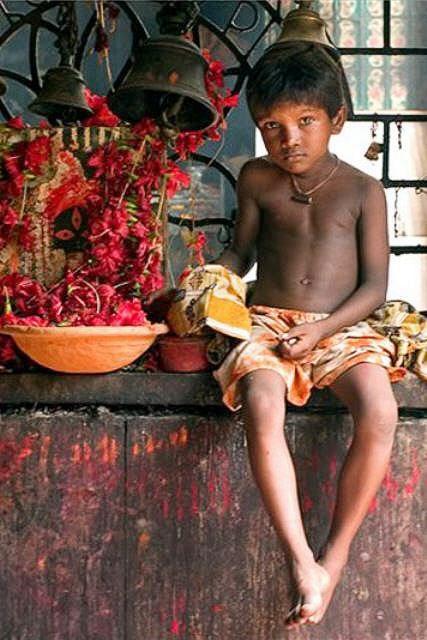
Hinduism: Temples

Figure 1.--The photo was taken in the patio in front of the Kali temple in Kolkata. Here there are many people selling garlands of flowers. That is a common offering of believers in Hindu temples. Mother Teresa's house is located nearby.
In the temple bare feet are compulsory, but there are no others dress rules. This is common in Hindu temples. In a few men can wear only lungi or dhoti. The boy probably is wearing his usual clothing.
|
|
The temple (Mandir) plays a much smaller role in the life of Hindus than many other religions such as Christianity, Islam, and Judaism where the church, mosque, and synagogue are very important. It is not mandatory for Hindus to visit a temple on even a weekly basis. Hindus usually have a shrine at home for daily prayers and worship. Hindus generally visit a temples only on special days. This can include auspicious occasions or religious festivals where communal celebration is important. Hindu temples notably do not play a crucial role in marriages and funerals. Rather the temple is the meeting place for religious discourses as well as ‘bhajans’ and ‘kirtans’ (devotional songs and chants). The various mandirs are dedicated to different gods and are the focus of Hindu religious life, although not individual worship. The temple is perhaps more important outside India, where Hindus are not a majority. Hindus outside India may gather at the mandir at the weekend and it becomes a focus of community life. Worshipers in the temples commonly repeat the names of their favorite gods, goddesses, and the associated mantras. This is commonly done individually. They offer water, fruit, flowers and incense to the gods. Hinduism began as a fusion between local beliefs and those of the Indo-Aryans who conquered the sub-continent during the Vedic period. At this time there were no temples. The principal object of worship was fire which came to be seen as the physical appearance of God. Worshipers would light the holy fire on a platform out in the open under the sky. Worshipers offered oblations to the fire. Historians are not certain when the Indo-Aryans first began building temples. This may have occurred at about the same time that idol worship began. Temples gradually became important as a sacred meeting place for communal worship and celebration of important festivals. As daily or even weekly communal worship was not seen as important, convenience for the worshiper was not as important as other religions. Thus Hindus often chose scenic locations for important temples, including river banks, hill tops, coastal locations. This is different than say Christianity where early churches were often built at locations where early Christian services were conducted in secret. Smaller temples, including open-air shrines, can be found at virtually any place. They can be found along the road or under a beautiful tree. Temples have been built at important Hindu holy places. Beautiful Hindu temples can be found at Amarnath, Ayodha, Brindavan, Banaras, Kanchipuram, Kanya Kumari, and many other towns.
HBC

Navigate the Boys' Historical Clothing Web Site:
[Teturn to the Main Hinduism page]
[Teturn to the Main religion page]
[Introduction]
[Activities]
[Biographies]
[Chronology]
[Clothing styles]
[Countries]
[Bibliographies]
[Contributions]
[FAQs]
[Glossaries]
[Images]
[Links]
[Registration]
[Tools]
[Boys' Clothing Home]
Created: 6:10 PM 12/16/2011
Last updated: 6:11 PM 12/16/2011



